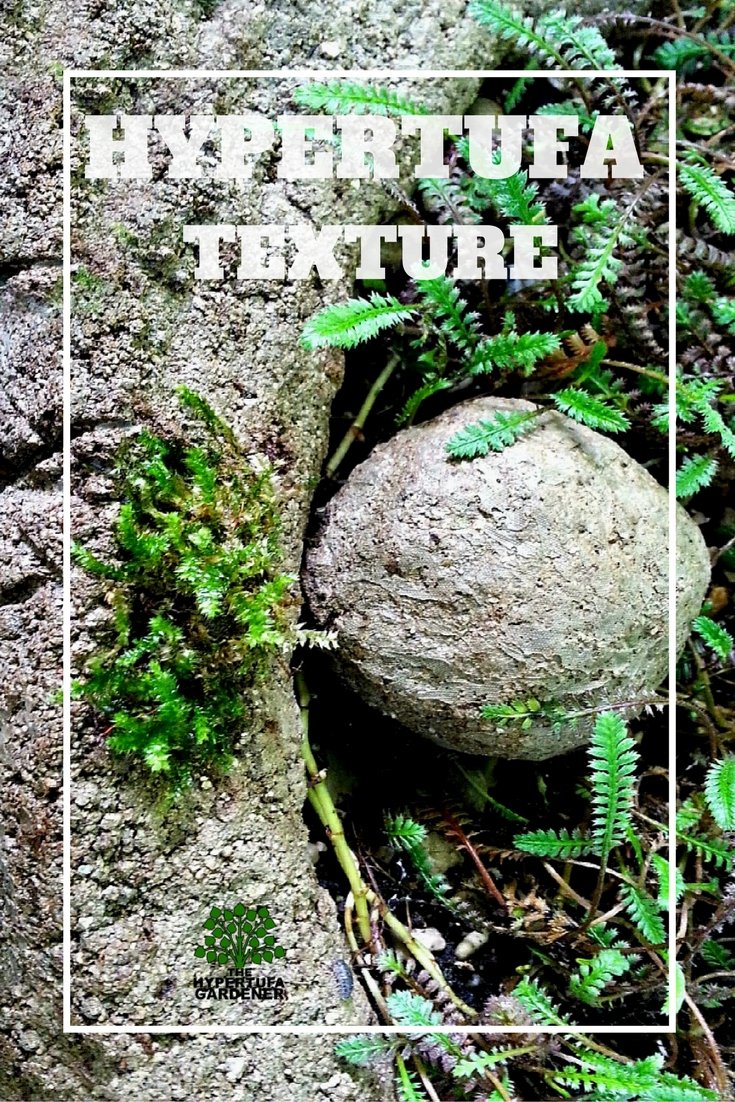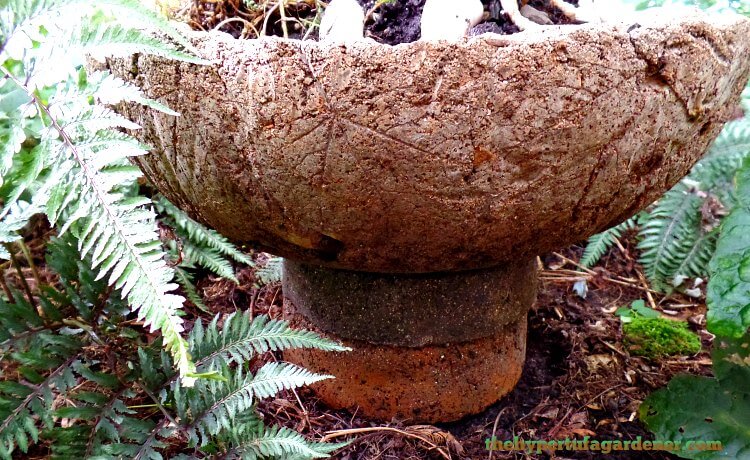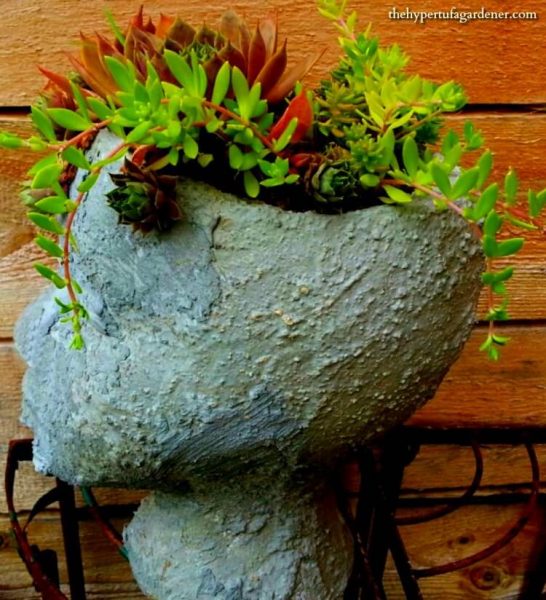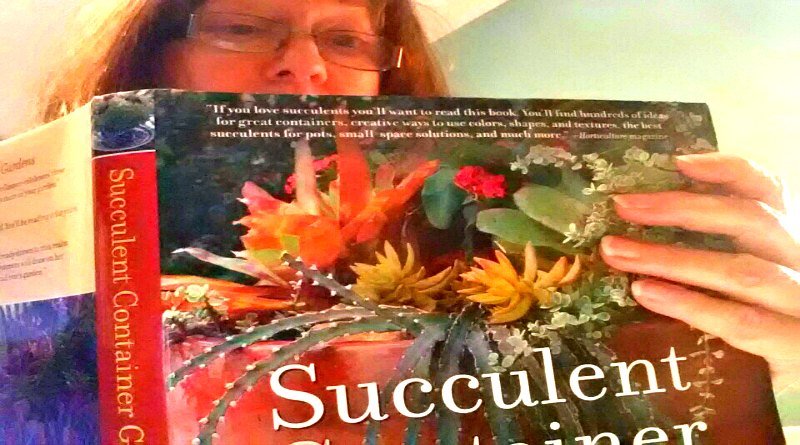Texturizing New Hypertufa – Give It That Aged Look
Old and pitted, lichens and moss embedded, that’s the look.
I love the look of the old stone troughs, those that look like the real thing: That ancient stone trough that some farmer carved from rock back in the 1890s. A trough like the one on page 125 of [easyazon_link identifier=”088192959X” locale=”US” tag=”thehypegard0d-20″]Debra Lee Baldwin’s book Succulent Container Gardens.[/easyazon_link] *My affiliate links are used in this post. However this does not influence or change my opinion. Thanks for using them and helping support my blog!*
Oh my, but that trough and that cascade of sempervivums on page 125 in her book just put me in my “Happy Place.” But I don’t have a few hundred dollars lying around for a planter! My husband would have a fit!

So I have learned to make my own and pray mine can look something as close to that as possible.
The work is in making the planter, but after that is done, you only have to wait that first 24-48 hr time period and then you can really get creative. I want mine to look like Elizabeth Bennett and Mr Darcy probably walked by it on the English countryside!
Or perhaps it was in the garden at Downton Abbey, right?
Working on your Hypertufa Trough
How do you get a great texture? You can really do anything to the hypertufa when it is in its first cure stage. I have even put designs with a dremel. So make yours unique and as personalized as you want.
When can you work the surface?
After your hypertufa cures for its first 24-48 hour time period, and you have removed it from the plastic bag or whatever wrappings you have it in, check to see if it feels a little gritty on the outside, but still very hard like concrete.
You can just about do anything to the outside walls of the planter at this time. It should be hard but still with a slight grittiness to the outside that you can scratch, for lack of a better word.
If you’ve had a bad day at work, or with the kids or husband, you can vent all your frustrations on this planter. If you have made nice thick sides, then the sky is the limit. Gouge and scrape as deeply and as wildly as you feel!

Use a screwdriver, that thingy you use to open paint cans , a wire brush, rasp, old forks or knives. Just be careful! Wear gloves while you do this. Hypertufa is rough and sharp against your hands, but also those tools you are using are fully capable of doing some serious damage with one slip! Your nails will suffer too. Don’t schedule that manicure before you do your texturing! Right?
Another method, just in case you already went for the manicure, is to use water.
(Wear your gloves anyway, hypertufa is still rough to handle.)
Yes, it is that easy for a bit of a different look. Put the planter on a table or bench, maybe you want to set something heavy in it, like a big old wench or hammer from the workbench. Then blast it with a garden hose set on a strong setting to make a strong jet of water. This can wash away a bit of the aggregate to give it a quick “aging.”
You can do this trying to hold it in your hand if the planter is small, but trust me, you’re gonna get a blast-back in the face, besides giving your husband a good laugh and another story to tell at family gatherings for the next few months. Been there. This will only slightly wash away some of the outer surface, exposing some peat moss which may wash out. This gives the side a pock-marked, ancient look.

Careful! Don’t let the jet of water knock it off the table and break.
Maybe a combination of all of these will work for your tastes. I like a rustic, aged appearance on mine. Yeah, page 125 again. I want it to look like it is 20-30 years old on its first day out of the mold. Maybe your tastes run for a smooth outside. But just do whatever appeals to you. You will find something you really like.
How have you texturized yours? Let me know. Show me some photos of yours on the Facebook Page. I have also created a group page for all you Hypertufa makers. Come join us and show us your stuff! The Hypertufa Gardener Group.



Is “Hypertufa” the pot? So you are making it with concrete, I assume? Do you just shape it into a pot or are you using a form of some kind?
I was wondering why in the third photo it looks brown…like a peat moss liner. I was wondering if you also use a dye to get different colors.
Visiting from “Blogging Fifty” Wednesday sharing links.
Pinned.
Thanks for your visit. Yes, I did use a cement colorant in some of the pots. Hypertufa is the medium that I work with and I explain that under the “How to” section. It is a mixture of cement, peat moss, and perlite. I don’t use concrete since it has so much gravel/aggregate.
I love hypertufa planters and made a large trough last year. It was quite an exhausting process as it required a good deal of mixture for the size I made. I aged it with a wire brush which worked well. I’m not sure how you have the energy to make the every day. ! would love more but 2 a year is about it. I think I need to improve the planting to do justice to the planter. I have DLB’s book. Must take another look for ideas. Thanks for the posting.
Oh, I know what you mean about exhausting, but that is my exercise. I made a huge trough last year which took a whole 94lb bag of Portland! But I love it.
Love this want to make some soon.
Try it and you will be hooked. It is fun!